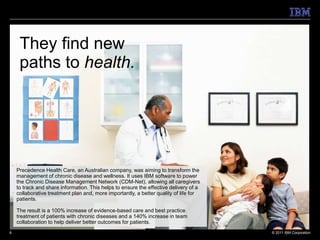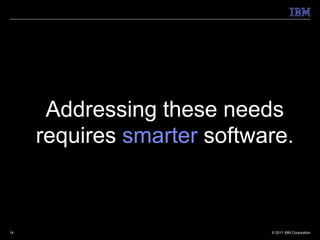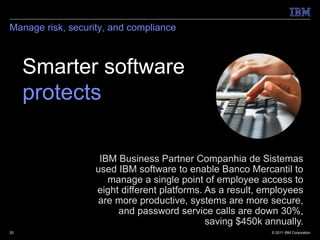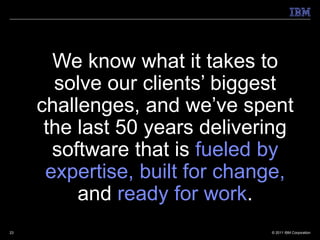Ad
The IBM Software Story (2)
- 1. George Mattathil - 8/22/2011 The IBM Software Story © 2011 IBM Corporation
- 2. On a smarter planet, software is changing the way people live. 2 © 2011 IBM Corporation
- 3. They do more with less. The City of Cambridge, Ontario, is using IBM software for asset management running on IBM System X hardware to gain insight and transform the way road maintenance is done. It now manages every aspect of infrastructure operations, maintenance and repair from end to end. As a result, it expects to eliminate over CAN$71M in repair backlog while saving a potential CAN$6M annually. In addition, it has increased the number of roads rated ―good‖ by 50 percent. 3 © 2011 IBM Corporation
- 4. They extend their reach. Globe Telecom – the #2 mobile operator in the Philippines – is using IBM software and BladeCenter hardware to integrate customer intelligence, behavior segmentation, profit simulation, and execution of hundreds of targeted promotions. As a result, they have cut the cost and time to deliver service promotions by 95% while increasing promotion related sales by 112%. 4 © 2011 IBM Corporation
- 5. They expand to new markets. VCC, a US-based construction company, is using IBM software to gain a foothold in new sectors. The solution allows a project manager to use a mobile device to send new job info into a CRM solution, which may launch a job scheduling app, attach a workflow, and distribute it to IBM Lotus Notes and mobile device calendars. This saves ~400 employee-hours per month, shortens sales cycles, contributes to 40% YTY increase in new business in high growth industries, and reduces customer service processing time by 30 to 50 percent . 5 © 2011 IBM Corporation
- 6. They find new paths to health. Precedence Health Care, an Australian company, was aiming to transform the management of chronic disease and wellness. It uses IBM software to power the Chronic Disease Management Network (CDM-Net), allowing all caregivers to track and share information. This helps to ensure the effective delivery of a collaborative treatment plan and, more importantly, a better quality of life for patients. The result is a 100% increase of evidence-based care and best practice treatment of patients with chronic diseases and a 140% increase in team collaboration to help deliver better outcomes for patients. 6 © 2011 IBM Corporation
- 7. They respond faster to demand. German retailer Karstadt enjoys a 38 percent share in the German warehouse business and has a turnover of €4 billion. To help manage its growth, the retailer improved its merchandise management information system using IBM InfoSphere and DB2 software running on System p hardware. The result is three times faster response times and savings of about €3 million per year. 7 © 2011 IBM Corporation
- 8. They better utilize resources. EWE AG Corporation, Germany’s leading developer for the energy and utilities industries, is used IBM software for design and development to provide consumers with full, web-based visualization of energy usage in real time. This enables them to easily understand the impact of their habits and leverage off-peak hours to save money and reduce peak loads. The result is reduced energy costs for consumers by 10 percent and a lower carbon footprint. 8 © 2011 IBM Corporation
- 9. Behind every one of these examples is a business, government or an industry that has used software in new ways. 9 © 2011 IBM Corporation
- 10. Today, more than ever, organizations use software to enable every facet of their business. Business Software 10 © 2011 IBM Corporation
- 11. But with new models and ways of working come new challenges... Global integration and Data everywhere connectivity As the world becomes more As the world becomesmore instrumented, the challenge is interconnected and as the to get more out of the wealth paradigm of the organization shifts of new information—from managing from multinational corporation data to developing insights. to globally integrated enterprise, businesses can no longer afford to operate as islands. More than ever, they need to find ways to connect both internally and externally. New expectations for value Customer expectations have never been higher: Personalized service, delivered flawlessly. Business Software Differentiation through Security risks Technology has allowed work people to move beyond physical locations As always, it’s the capabilities and and brand offices. ingenuity of the people in business It now exists on virtual platforms, that deliver results. But today, it’s across dispersed teams and about more than just those on your players. But the more data and payroll—the greater opportunity information organizations make is how well you can engage a available to their internal audience, worldwide ecosystem of employees, the greater the risk. partners, suppliers, and customers to help create new value. 11 © 2011 IBM Corporation
- 12. And as a result, a new set of needs has emerged. Turn information into insights Drive business integration and optimization Connect & collaborate Business Enable business Software service & product innovation Optimize the impact of business infrastructures and services Manage risk, security & compliance 12 © 2011 IBM Corporation
- 13. These needs range from building technology advantage to developing new strategic business solutions. Business solutions ― I need to make better use of my company’s information. That means my company has to do a better job managing data and content. With timely access to clean data, we could Turn information into devise new ways to serve our customers.‖ insights ― I need to create the processes and flexible Drive business infrastructure our organization needs to react integration and more quickly to changing market conditions.‖ optimization ― I need better ways to connect my team to Connect & improve their productivity and ability to make collaborate timely decisions. By connecting key processes and enhancing collaboration, we can be more Enable business ― I need to deliver smarter products, services and responsive to our customers and partners.‖ service & product capabilities more efficiently and reduce cost and innovation risk across the product and application lifecycle, while also providing better service experiences to Optimize the impact my end customers.‖ ― I need to create more efficiency within our existing infrastructure. That starts with greater of business visibility and control across all of our operations— infrastructures and both IT and enterprise—and better management services of our overall resources.‖ ― I need to ensure that my organization is pro-actively Manage risk, identifying all the different types of risks to our security & business, and that we have security and resiliency compliance plans in place to address any threat or disruption.‖ Technology advantage 13 © 2011 IBM Corporation
- 14. Addressing these needs requires smarter software. 14 © 2011 IBM Corporation
- 15. Turn information into insights Smarter software knows & acts. Belgian Red Cross-Flanders supplies 99 percent of the blood required by Flemish hospitals. Using IBM software, Business Partner Numius automated reporting to enhance inventory management, identify blood-type needs, improve stock management, and learn how to attract new donors while significantly reducing costs. 15 © 2011 IBM Corporation
- 16. Drive business integration and optimization Smarter software adapts. The city of Madrid needed to radically improve its emergency response capability. With IBM software and Business Partner Indra, it now integrates incident data into a unified view, coordinates resources end-to-end, connects wirelessly to responders, and has cut response time by 25%. 16 © 2011 IBM Corporation
- 17. Connect & collaborate Smarter software connects. Hearst Direct, a US media company, turned to IBM Business Partner Ixion LLC for a self- service web portal based on IBM software. With easy access to info and fewer errors, the portal enables a high-touch relationship with customers and a potential 10 to 15% gain in productivity. 17 © 2011 IBM Corporation
- 18. Enable business service and product innovation Smarter software monitors & controls. Brockwell Technologies provides systems management solutions to the US Department of Defense and other clients. With IBM software, it uses predictive modeling and simulations to identify design flaws early, before mass production. Result: time-to-market cut by 40%. 18 © 2011 IBM Corporation
- 19. Optimize the impact of business infrastructures and services Smarter software optimizes. In order to reduce its carbon footprint, Bryant University used IBM Tivoli software and BladeCenter hardware to consolidate four server rooms into one data center. As a result, it reduced operational expenses by 21% and capital expenditures by 26% while improving service delivery by 15%. 19 © 2011 IBM Corporation
- 20. Manage risk, security, and compliance Smarter software protects. IBM Business Partner Companhia de Sistemas used IBM software to enable Banco Mercantil to manage a single point of employee access to eight different platforms. As a result, employees are more productive, systems are more secure, and password service calls are down 30%, saving $450k annually. 20 © 2011 IBM Corporation
- 21. At IBM, we believe software can make the world better, one client at a time. 21 © 2011 IBM Corporation
- 22. A lot of other companies claim to do the same thing. But they don’t. They can’t. Their software doesn’t work like our software. 22 © 2011 IBM Corporation
- 23. We know what it takes to solve our clients’ biggest challenges, and we’ve spent the last 50 years delivering software that is fueled by expertise, built for change, and ready for work. 23 © 2011 IBM Corporation
- 24. Fueled by expertise We know software. But more importantly, because we’re Proof points IBM, we know how software connects to hardware 40 innovation centers worldwide, focused on solutions for dozens of connects to services—and what it takes to make industries technology infrastructure run. 65,000 software employees 35,000 software developers But we also know how to apply software for real results. 80 R&D labs We know industries, the world of business, and how work 30,000 partners gets done. We know systems, both natural and man- Largest middleware company in made. We know how the world really works, and what it the world takes to make the world work better. 24 © 2011 IBM Corporation
- 25. Built for change Our software is open. Easily integrated. Flexible. Built with Proof points a systems POV. Old, new. Ours, theirs. IBM software 100+ acquisitions works with what clients have today, and what they will 300 SOA patents need tomorrow. IBM contributes to over 150 open source projects—more than any other company. But we’re not just capable of change. We believe it’s not IBM has invested over $1B in enough to simply be ready for change when it happens. Linux and open source, and We have forward-looking labs and researchers whose continues to invest several hundred million dollars annually. sole purpose is to help our clients be prepared for the future. Whether built here or bought elsewhere, our software helps clients anticipate the needs of their business. 25 © 2011 IBM Corporation
- 26. Ready for work We build software that’s robust. Industrial-strength. Proof points Proven. Ready to scale. Whether for start-ups, Fortune 50 Middleware market share leader, with nearly twice the share of our companies, or entire governments, our clients can always closest competitor count on our software to deliver the impact. Heavy investment in software, now representing 44% of IBM net income But it isn’t just the code of our software that ensures our 25,000 sales & support staff clients’ success. It’s also about the ongoing service we dedicated to client success provide. We’ve always been dedicated to our clients’ Major acquisitions in such key areas as business analytics, BPM, mobile every success—big and small—and our teams work and cloud computing tirelessly alongside clients to apply software to solve their greatest challenges and create new value. 26 © 2011 IBM Corporation
- 27. Fueled by Built for Ready for expertise change work Business Prepared Dedicated – Deep industry knowledge – Designed to help predict and – More than the code, IBM delivers embrace change the personal service to apply – Applying our deep understanding software to clients’ biggest of client needs, how business – Solves short term challenges and challenges works and how the world works to take advantages of future the software we deliver opportunities – Working with clients to anticipate the needs of their business & & & Technology Open Proven – Deep knowledge of software – Flexible – Robust – Heritage of integrating hardware, – Easily integrated with current and – Industrial strength software and systems future infrastructure, inside and – Ready to scale outside clients’ organizations – Efficient – Secure 27 © 2011 IBM Corporation
- 28. We deliver software that provides clients the capabilities required to transform their industries. Energy and Utilities Aerospace and Defense Retail Application Complex and Information Integration Transportation Consumer Products Education Infrastructure Embedded Systems and Federation Banking Healthcare Life Sciences Application Lifecycle Connectivity and Network and Service Financial Markets Telecommunications Media and Entertainment Management Integration Assurance Electronics Government Automotive Asset Management Data Management Security Industrial Products Insurance Chemical & Petroleum Business Analytics Data Warehousing Social Business Application Business Planning and Design, Development, Development Alignment and Deployment Social Collaboration Business Process Enterprise Content Management Management Storage Management Business Service Enterprise Marketing Systems Management Management Management Unified Cloud and Enterprise Communications Virtualization Modernization Web Experience Management Information Commerce Governance 28 © 2011 IBM Corporation
- 29. What’s your vision for your organization? What’s your biggest challenge? Let's talk. 29 © 2011 IBM Corporation
- 30. Trademarks and notes IBM Corporation 2011 § IBM, the IBM logo and ibm.com are registered trademarks, and other company, product or service names may be trademarks or service marks of International Business Machines Corporation in the United States, other countries, or both. A current list of IBM trademarks is available on the Web at ―Copyright and trademark information‖ at www.ibm.com/legal/copytrade.shtml § Adobe, the Adobe logo, PostScript, the PostScript logo, Cell Broadband Engine, Intel, the Intel logo, Intel Inside, the Intel Inside logo, Intel Centrino, the Intel Centrino logo, Celeron, Intel Xeon, Intel SpeedStep, Itanium, IT Infrastructure Library, ITIL, Java and all Java-based trademarks, Linux, Microsoft, Windows, Windows NT, the Windows logo, and UNIX are trademarks or service marks of others as described under ―Special attributions‖ at: http://www.ibm.com/legal/copytrade.shtml#section-special § Other company, product and service names may be trademarks or service marks of others. § References in this publication to IBM products or services do not imply that IBM intends to make them available in all countries in which IBM operates. © 2011 IBM Corporation
- 31. The bottom line is still top priority Although the global economy is on the road to recovery, many organizations may still be: Concerned about the high cost of acquiring and maintaining technology Keeping a close watch on their IT investments Demanding that every investment provide a quick return Conserving capital wherever possible Favoring short-term over long-term initiatives “The economic downturn has rewritten the rules of IT investment, and IT organizations will need more-rigorous investment management practices in order to adapt. Only then can IT organizations meet the business requirement to continue to improve IT efficiency, while increasing the value delivered to the enterprise.” —Gartner Research, New Realities of IT Investment, September 27, 2010 31 © 2011 IBM Corporation
- 32. IBM Global Financing can help IBM Global Financing helps companies acquire the IT solutions they need, more easily and cost-effectively, so they can: – Preserve cash for strategic business needs – Obtain the solutions they need— potentially without cutting back We are the world’s largest technology financier, providing services in more than 55 countries We work with more than 125,000 clients, from small businesses to large enterprises, including roughly 80% of the Fortune 100 Our decades of IT expertise give us an exceptional understanding of a company’s 55+ 125,000+ countries clients technology and financial needs 32 © 2011 IBM Corporation
- 33. Support for your vision IBM Global Financing We are well positioned We can help accelerate delivers the IT financial to assist you with not only the implementation of expertise and capabilities financing but also IT life- innovative solutions or you need today to cycle management projects such as cloud support your vision for challenges computing or business tomorrow analytics 33 © 2011 IBM Corporation










































































![Ibm client strategy final [v4]](https://cdn.slidesharecdn.com/ss_thumbnails/ibmclientstrategyfinalv4-141201025812-conversion-gate01-thumbnail.jpg?width=560&fit=bounds)














































